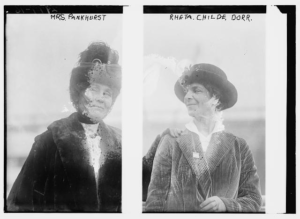As the final installment of our series to commemorate the centennial anniversary of women’s suffrage, we wanted to take the opportunity to shed light on one more Nebraska woman who played an important role in woman’s suffrage as a young woman, and who then continued to be an influential voice for women’s equality on an international scale.
Doris Stevens was born Dora Caroline Stevens in Omaha in about 1888 (or 1892). She graduated from Omaha High School in 1905, after which she attended Oberlin College, where she studied music and sociology and became involved in the suffragist cause. By 1914, she was the national strategist for the Congressional Union for Woman Suffrage. This time, the movement sought to pursue ratification at a federal level, rather than state-by-state, so Doris Stevens coordinated with 435 congressional districts across the country. She traveled the country in an effort to organize women in the states where suffrage had already been achieved, convincing them to use their votes to oppose any candidates who did not support national suffrage.

Doris Stevens on her way to Colorado to attend a nation conference of the NWP, 1916. Image courtesy of the Library of Congress.
At the beginning of World War I, she criticized President Wilson, saying it was “arrogant [of him] to fight for democracy abroad when women were not included in democracy at home.”[1] She was a prominent member of the Silent Sentinels, the group of women who picketed the White House from January 10, 1917 until June 4, 1919. She would alternate attending speaking engagements and picketing, for which she was arrested multiple times. She would publish the book Jailed for Freedom in 1920, as a record of the events leading up to ratification. As she says in the Preface:
There are two ways in which this story might be told. It might be told as a tragic and harrowing tale of martyrdom. Or it might be told as a ruthless enterprise of compelling a hostile administration to subject women to martyrdom in order to hasten its surrender. The truth is, it has elements of both ruthlessness and martyrdom. And I have tried to make them appear in a true proportion. It is my sincere hope that you will understand the martyrdom involved, for it was the conscious voluntary gift of beautiful, strong, and young hearts.

L to R: Doris Stevens, Alison Turnbull Hopkins, and Eunice Dana Brannan in prison dress, probably at the Occoquan Workhouse, 1919. Image courtesy of the Library of Congress.
Once ratification had been achieved, Doris Stevens continued to fight for further enfranchisement of women in the United States and abroad. She was an active member in the National Women’s Party in New York, where she worked on proposals to grant women equal rights. She and Alice Paul began a large-scale study of women’s rights and nationality, meeting with feminists in Europe and throughout the Americas to establish an index of all laws controlling women’s nationality from every country in its native language, accompanied by a translation. Doris Stevens was instrumental in the creation of the Inter-American Commission of Women, a group of seven female delegates working to finalize this research for presentation at the 1933 Pan-American Conference. During this time, she also attended international law and foreign policy courses at the American University and Columbia University.

Doris Stevens working with the Women’s Consultative Committee at the League of Nations, ca. 1931. Stevens is at the center holding a pen, and Alice Paul is standing behind her. Image courtesy of the Library of Congress.
At the 1933 Pan-American Conference, the first-ever international agreement on women’s rights was adopted. It stated that “There shall be no distinction based on sex as regards to nationality.” (If a woman were to marry a man of another nationality, she would now be able to retain her citizenship, and neither marriage nor divorce could affect her nationality, nor that of any children involved.)
In the late 1930s and early 1940s, clashes with FDR’s administration, the League of Women Voters, and a falling-out with Alice Paul resulted in Doris Stevens leaving the National Women’s Party and continuing her feminist work with the Lucy Stone League, ultimately serving as the league’s vice president. Toward the end of her life, she worked to have feminist studies recognized as a legitimate field of study in American universities. She also continued to write music throughout her life, including songs about her early days in Nebraska, such as “Lake Manawa”, “On the Prairie”, and “I Was Teaching in Nebraska”.[2]
Because this year is an election year, you can show your appreciation for Doris Steven’s work toward voting equality by making sure you’re registered to vote! https://vote.gov/
[1] “Women We Celebrate: Doris Stevens”. Sewall-Belmont House & Museum. Washington, DC: Sewall-Belmont Organization. 2011.
[2] Doris Stevens Papers. History Nebraska. https://history.nebraska.gov/collections/doris-stevens-rg3740am


